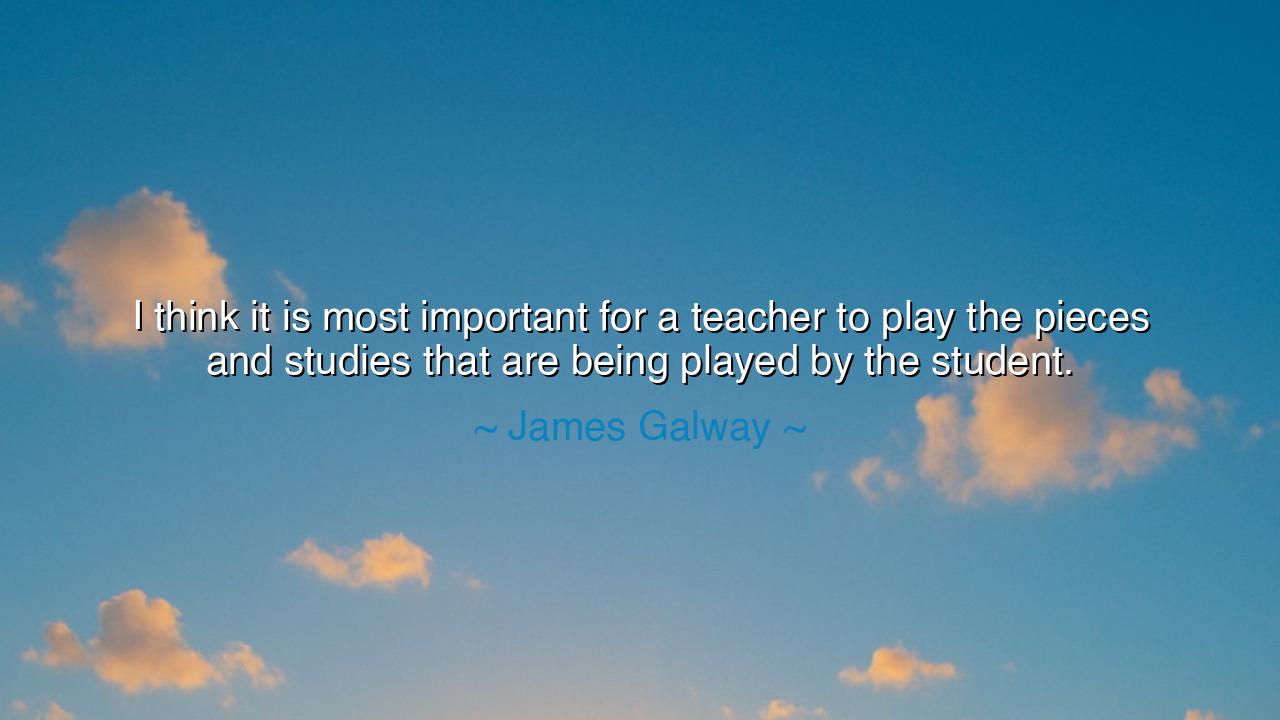
I think it is most important for a teacher to play the pieces
I think it is most important for a teacher to play the pieces and studies that are being played by the student.






Hear the words of James Galway, master of the flute: “I think it is most important for a teacher to play the pieces and studies that are being played by the student.” In this statement lies a profound wisdom, for Galway speaks not only of music but of the sacred bond between teacher and student. He reminds us that a teacher cannot stand aloof, dictating from a high place, but must descend into the very struggle of the learner. Only then can true guidance be given, for to teach is not to command but to walk beside.
To play the same pieces is to show solidarity, to say, “I, too, have wrestled with these notes; I, too, have stumbled where you stumble.” In this way, the teacher does not stand as a distant authority but as a fellow traveler on the path of mastery. The student sees not only what should be done but how it may be done, embodied in sound and gesture. Thus, the abstract becomes concrete, and the mystery of art is revealed through living example. This is the teaching of Galway: that the teacher’s greatest gift is to demonstrate with the same tools the student is learning to wield.
This principle is not new. Recall the story of Socrates, who never stood apart as a lecturer but engaged his students in dialogue. He asked the same questions they wrestled with, shared in their confusions, and walked with them step by step toward truth. His wisdom did not flow downward from a pedestal but arose in the shared struggle of inquiry. So too in music—or in any craft—the teacher who “plays the pieces” is like Socrates: he guides not by decree, but by example and participation.
History gives us also the tale of Leonardo da Vinci, who trained under Andrea del Verrocchio. When Leonardo painted an angel in his master’s work The Baptism of Christ, it is said Verrocchio was so humbled by the brilliance of his student that he laid down his brush. Yet before that moment, Verrocchio had painted alongside his pupil, working on the same canvas, teaching by doing. The student learned not by words alone, but by seeing the very strokes of the master. This is Galway’s vision: a teacher who does not merely tell but shows, who shares the labor of learning.
The wisdom here is twofold. First, it teaches humility—that a teacher must never think themselves above the struggles of the student. Second, it teaches embodiment—that instruction without example is hollow. The student learns as much from the sound of the teacher’s flute, the movement of the hands, the shaping of the breath, as from any words spoken. In every art, the living demonstration carries a power that instruction alone cannot match.
What then is the lesson for us? It is this: if you are a teacher, do not merely speak—do. If you are a guide, walk the same path your student walks. Take up the same exercises, confront the same difficulties, and show how you have mastered them. And if you are a student, seek not only words from your teacher but example, for in seeing and hearing lies the deeper teaching. This is true in music, in craft, in virtue, and in life itself.
So I say unto you: remember Galway’s words. The teacher must play alongside the student, not as one above but as one beside. This is the way of true instruction, where knowledge is not delivered but shared, where wisdom is not commanded but revealed. In this way, the bond between teacher and student becomes not a ladder of authority but a fellowship of growth, and both are lifted higher by walking together.






AAdministratorAdministrator
Welcome, honored guests. Please leave a comment, we will respond soon